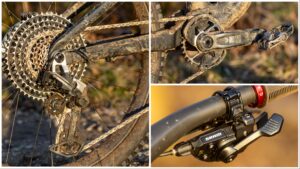Does F1-inspired suspension bring benefits to mountain biking?
Trek Remedy 9 29 (2015) longterm review
Key points
- 29er trail bike with 140mm travel and enduro-bike stiffness
- Newfangled RE:aktiv damper from Fox and Penske Racing
- Mino link adjustable geometry to fettle head angle and BB height
- Internal cabling, 1×11 drivetrain, Reverb Stealth dropper post

What attracted you to the Trek Remedy 9 29?
The colour, the fact it cost more than my car, and the stunning array of technology firsts from Trek. Plus-size bikes are spreading Boost 148 hub popularity far and wide, but the Remedy got there first, with its ultra-wide back end and stiffer rear wheel.
Then there’s the new RE:aktiv shock, designed with Fox and US race-car engineers Penske to give more pedalling support and still offer a plush feel for maximum grip. The Holy Grail?

Did you change anything straightaway?
It’s so long ago, memory fails me, but a close look at the photos from my first report, back in May, show something alarming — a saddle pack slung underneath the seat, presumably holding tools. The shame of it; ruining the Trek’s lines with that monstrosity.
I swapped the dry tyres for muds a few weeks later, fitted a wider bar and shorter stem and added a mudguard that I’ve never had cause to remove.

Was the bike easy to set up?
Yes, initially. You have to cycle the shock through at least 50 per cent travel when setting it up to ensure air gets into its second DRCV chamber, but that’s the only difference from a regular full-sus configuration — set the sag to 30 per cent and go riding. The hard work came later.

How did it ride?
The RE:aktiv shock didn’t deliver on its promise. I mean that in a good way, the Remedy doesn’t have the pedalling platform it boasts of, but I really couldn’t give a flying lump of mud — the suspension is incredibly sensitive and it makes the bike feel exciting, full of pop and brilliantly fast.
It’s very active on climbs though, so I’d flip the blue lever to climb mode, where you can actually hear the tick of the valve inside the shock opening and closing as you pedal.
Watch how to fit offset hardware
The bottom bracket is too high to really feel comfortable at speed though, so I set about lowering the bike with offset shock hardware.
And if a job’s worth doing, it’s worth doing well, I thought, so I added angled cups too and slackened the head angle to 65 degrees. I’m left with a long, low and slack trail bike that feels brilliant.

Did anything break or wear out?
No, it’s so sturdy it feels unbreakable. You wouldn’t expect breakages on this top-end equipment either.
If you could change one thing about your longtermer what would it be?
Trek fits an increased offset fork to the Remedy, and I think the idea is to make the steering quicker. That’s bad in my book though, I want it slow and controlled, so I’d do away with that and fit a Pike with regular offset.

Would you buy this bike and why?
Six months ago, half way through the test, I’d have said no. But now I’ve worked out how easy and cheap it is to sort the Remedy, I’ve got to say yes. The bike’s a lot of money but it’s worth it: light, stiff and brilliant. The colour’s too garish for me though.
















